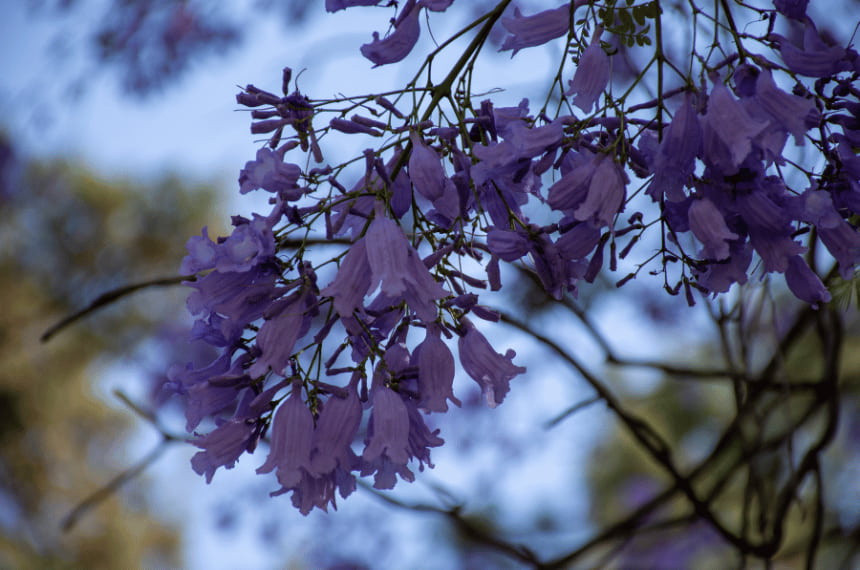Australia is a horticultural haven, boasting unparalleled flora and fauna. Purple flowering trees like the iconic Jacaranda Mimosifolia and Tibouchina’ Alstonville’ stand out among its natural treasures, gracing landscapes from cities to hinterlands. With their exotic origins, these trees have seamlessly woven into Australia’s identity, offering visual splendour and environmental benefits. As they burst into vibrant hues from Mackay to Melbourne, they remind us of nature’s artistry and importance.
So, explore this guide because it’s your passport to understanding the beauty and benefits of Australia’s iconic purple flowering trees!
Benefits and features of purple flowering trees
Purple flowering trees display their vibrant colour and the vast range of benefits they bring to our environment. Let’s dive deeper into the advantages presented by these uniquely Australian plants.
Aesthetic appeal of purple flowering trees
The first factor to note is undoubtedly their aesthetic appeal. Whether you’re an artist with a penchant for nature or someone who enjoys a little beauty in your surroundings, purple flowering trees offer an alluring sight that’s hard to resist.
Among Australia’s various purple flowers, each blooms at different times throughout the year, consistently blessing us with visually captivating scenes. The Jacaranda tree, characterised by its lavish waves of radiant lavender flowers, stands out gorgeously against lush green foliage or crystal blue skies.
Creative landscaping can leverage the purple colour plant’s pop to form intricate contrasts and enhance your outdoor spaces’ charm—whether it’s residential gardens, public parks or street avenues.
Imagine seeing a serene view with shades of indigo, lilac and plum. Integrating diverse shades – from soft pastels to deep wine-coloured hues – heightens visual interest within your beautiful yard.
Environmental benefits of purple flowering trees
Australian trees with purple flowers are visually captivating and offer significant environmental benefits. Here’s a breakdown of their multifaceted advantages:
- Biodiversity boost: These trees play a crucial role in maintaining Australia’s ecosystem diversity.
- Pollination: Vibrant blossoms attract insects like bees, promoting pollination and fostering growth across various plant communities.
- Avian attraction: Birds, especially nectar feeders like lorikeets and honeyeaters, thrive by feasting on these floral treasures.
- Carbon sequestration: Purple flowering trees are vital carbon sinks, absorbing CO2 and releasing oxygen, aiding climate change mitigation.
- Air quality: Their role in reducing greenhouse gases significantly improves air quality.
- Urban planning: Due to their low maintenance and adaptability, they’re ideal for urban spaces, acting as noise barriers, providing shade, and reducing urban heat.
- Enhanced liveability: They contribute to making cities more livable by offering multiple environmental benefits.
- Aesthetic and environmental harmony: These trees blend visual appeal with environmental prosperity, transforming landscapes and promoting eco-friendly living.
Considering their myriad benefits, introducing these trees to gardens can be a holistic approach to beautifying spaces while championing sustainability.
Popular varieties of purple flowering trees in Australia
Before we delve into the specifics, let me provide a brief overview. From magnificent Jacarandas to delicate Hibiscus Syriacus species, this list encompasses some of Australia’s most dazzling purple flowering trees.
I’ve included care information and the best-growing conditions for these eight varieties- because understanding your green friends is vital before choosing one as a permanent yard resident.
1. Jacaranda Mimosifolia

The first gem on our list is the famed Jacaranda Mimosifolia — quintessentially iconic in Australian landscapes. With striking clusters of vibrant purple-blue blossoms draped over soft fern-like leaves, it’s an absolute spectacle in full bloom between October and December. Don’t forget its jacaranda origin; it reflects its resilient adaptation attributes, adding more intrigue to this tree.
Best growing conditions
Native to South America, this lovely purple artist prefers well-drained soil and flourishes under extensive sun exposure. An optimal growth condition would be warm coastal conditions; however, they are adaptable to varying climates except for frost-prone areas.
Care and maintenance tips
Water young Jacarandas deeply until matured – usually 3-4 years. Then, limit watering, allowing them better seasonal acclimation and resistance towards illnesses like root rot. Annual pruning will ensure a structurally sound tree that thrives year-round.
2. Tibouchina ‘Alstonville’

A splendid entry in our purple plant Australia category is Tibouchina ‘Alstonville’. Famous for its rich royal-purple flowers set against velvety green foliage, it is a strikingly attractive feature tree or shrub during springtime.
Best growing conditions
This drought-tolerant variety prefers well-composted soils with good drainage & ample sun-lit spaces, ensuring spectacular blooming seasons. It’s suitably adaptable across Australian climates, particularly warm coastal regions.
Care and maintenance tips
Single-yearly feedings of balanced plant food during early spring alongside regular mulching should suffice for these low-maintenance trees. Light prune post-flowering to maintain the desired shape.
3. Tibouchina ‘Jules’
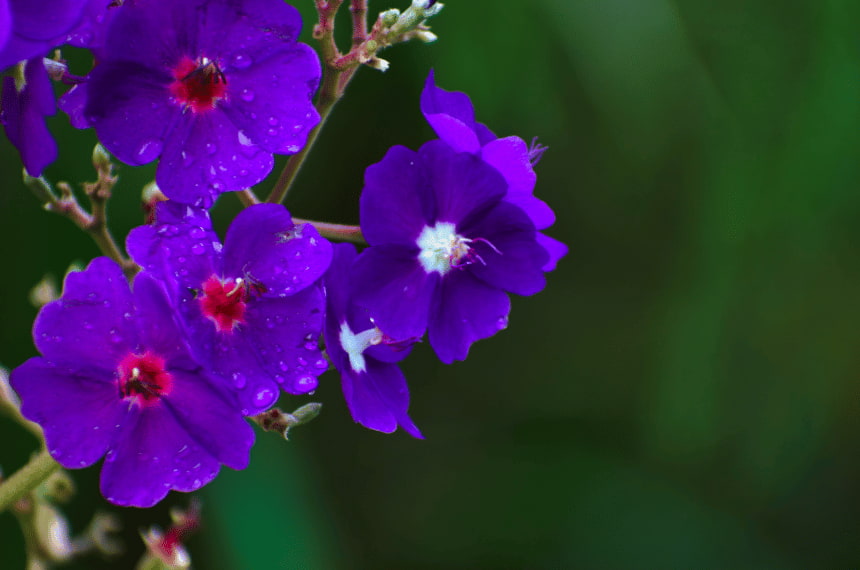
Tibouchina ‘Jules’ is a dwarf variety gracing Australia with its vibrant amethyst flowers through summer until autumn. Given suitable conditions, this small tree with purple flowers can stand out as a beautiful garden speculator in any Australian yard.
Best growing conditions
This Tibouchina variant prefers acidic to neutral soils, favours plentiful sunlight, but can tolerate part-shade too. A cosy, sheltered location encourages optimal growth and abundant flowering.
Care and maintenance tips
Trim right after their blooming phase in late winter or early spring for shaping purposes. Regular watering is ideal, but it’s worth allowing the soil to dry before subsequent watering.
4. Magnolia Soulangeana Royal Purple
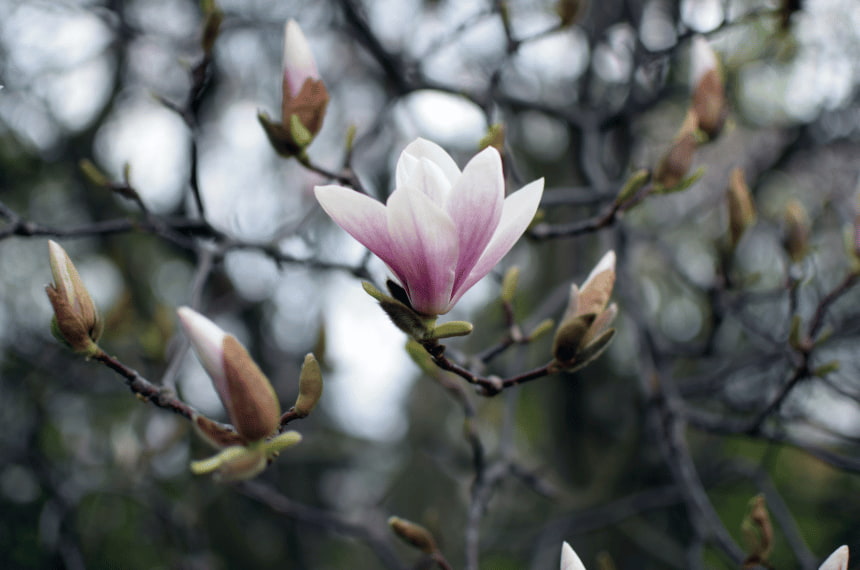
Keeping on the royalty theme, we present you with Magnolia Soulangeana’ Royal Purple’. This deciduous magnolia mesmerises with its large, fragrant, tulip-like dark purple blooms appearing pre-foliage from mid-winter through spring.
Best growing conditions
The tranquillity of partially shaded places appeals more to our royal magnolia paired with organically rich, well-drained soil to ensure optimal growing circumstances.
Care and maintenance tips
A periodic slow-release fertiliser application following scheduled pruning will work wonders in maintaining good health while optimising its blossoming potential.
5. Hibiscus Syriacus

Hibiscus Syriacus, often called the Rose of Sharon, is technically a shrub but can grow quite large, making it suitable as a feature tree in many gardens. This species can reach impressive heights of up to 4 metres.
There are various cultivars available, boasting either single or double purple blooms. The Hibiscus Syriacus is not just limited to subtropical and tropical regions; it’s versatile enough to be grown in most parts of the country. This is because it can tolerate conditions like frost and mild drought, while thriving in both full sun and part shade.
Best growing conditions
While many associate Hibiscus with warmer climates, the Hibiscus Syriacus is adaptable. It can withstand frost and mild drought conditions. Ideally, it should be planted in locations that receive either full sun or part shade. This species is quite hardy and can adapt to various conditions, making it a favourite among gardeners.
Care and maintenance tips
Hibiscus Syriacus requires minimal maintenance. Regular pruning can help maintain its shape and promote more vigorous flowering. Ensuring the soil is well-draining is essential, as Hibiscus plants generally don’t like to sit in soggy conditions. While they can tolerate mild drought, it’s a good practice to water them regularly, especially during dry spells. If you want to boost its growth and flowering, consider adding a balanced fertiliser during its growing season. Periodically check for pests like aphids, which might be attracted to its lush foliage and vibrant flowers.
6. Bauhinia Purpurea (Purple Orchid Tree)
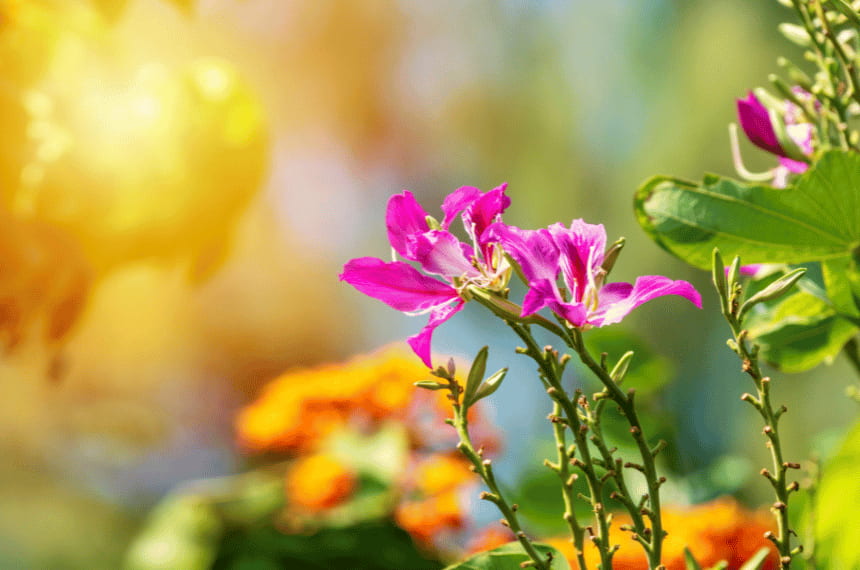
Bauhinia Purpurea, commonly known as the Purple Orchid Tree, is a fast-growing deciduous tree native to South Asia. It stands out with its heart-shaped leaves and remarkable purple flowers that, when fully open, resemble a butterfly. The blooms are not only visually striking but also fragrant and quite large. The tree can reach impressive heights of up to 10 metres, making it notable in any garden or landscape.
Best growing conditions
The Purple Orchid Tree thrives in warm temperate to tropical regions. It prefers areas that offer protection from frost, strong winds, and drought. Given its origin and characteristics, it’s best suited for climates that mimic its native habitat in South Asia. However, with the right care, it can adapt to various conditions.
Care and maintenance tips
While resilient, this tree requires some attention to ensure it grows optimally. Protection from strong winds is crucial, and if you’re growing it in a pot, you can move it to a more sheltered spot when necessary. Regular watering is essential, especially during dry spells, but ensure the soil is well-draining to prevent root rot. Given its rapid growth, occasional pruning might be needed to maintain its shape and promote more vigorous flowering.
7. Chaste Tree (Vitex agnus-castus)

The Chaste Tree, scientifically known as Vitex agnus-castus, has a rich history and is often called Monk’s Pepper. This is because monks historically consumed its seeds to maintain their chastity. The tree is adorned with long trusses of lilac-purple blooms that appear on tall stems during mid-summer, followed by dark purple fruits. These small purple flowering trees can grow up to 3-4 metres tall, making them an ideal choice for front yards or smaller gardens. The aromatic grey-green leaves with shimmery silver undersides add to its charm.
Best growing conditions
Chaste trees are hardy and can tolerate a variety of conditions. They prefer full sun but can also thrive in partial shade. While they are relatively drought tolerant, they flourish best in well-drained soils. Their adaptability makes them a popular choice among gardeners.
Care and maintenance tips
These trees are low maintenance, but a few care tips can ensure they remain healthy and vibrant. Regular watering is essential, especially during dry periods. However, it’s crucial to ensure the soil doesn’t become waterlogged. Pruning can be done to shape the tree and promote more vigorous flowering. Additionally, watch for pests and diseases and treat them promptly to ensure the tree’s health and longevity.
8. Lagerstroemia ‘Purple Magic’
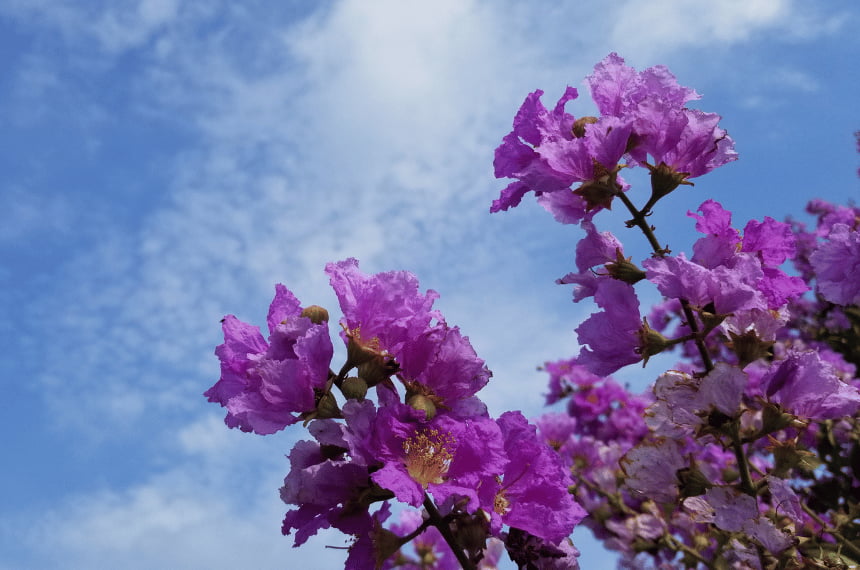
Lagerstroemia’ Purple Magic’, commonly known as Crepe Myrtle, is a standout variety among the family. This particular variant is celebrated for its deep purple blooms that create a stunning contrast against its dark green foliage. The flowers are crinkly, resembling crepe paper, blossoming on the branch tips. ‘Purple Magic’ is a compact variety, making it suitable for smaller gardens or as a feature plant in larger landscapes. The tree also showcases an attractive exfoliating bark, adding winter interest.
Best growing conditions
Crepe Myrtles, including the ‘Purple Magic’ variety, thrive in full sun, which helps them produce the most vibrant flower colours. They prefer well-drained soil and are quite drought-tolerant once established. While they can handle various soil types, slightly acidic to neutral soils are ideal for optimal growth.
Care and maintenance tips
Lagerstroemia’ Purple Magic’ is relatively low maintenance. Regular watering is essential during its initial growth phase, but once established, it can handle periods of drought. For a more prolific bloom, deadheading spent flowers can promote a second flush of blossoms. Crepe Myrtle pruning can be done in late winter or early spring to maintain the desired shape and remove dead or diseased branches. A slow-release fertiliser applied in the spring can boost its growth and flowering potential. As with all Crepe Myrtles, monitoring for pests like aphids and treating them promptly is essential.
Cultivation and growth tips for purple flowering trees
One cannot simply plant a tree and expect it to thrive. It takes understanding, effort, and appropriate care tactics tailored specifically according to the tree species. Here are some insights into techniques ideal for nurturing purple flowering trees in Australia.
Soil preparation and planting techniques
The first step to successful cultivation lies in preparing your soil correctly. Most purple-flowered trees in Australia prefer well-drained, fertile, loamy soils. However, several types, such as the hardy Jacaranda tree, can adapt to various soil conditions.
Dig a hole twice the size of the root ball for planting, but ensure it’s not too deep; you want your sapling at ground level. Layer some compost or organic matter at the bottom of the hole if your soil is sandy or heavy clay. Place your tree gently into this hole, and backfill with excavated soil mixed with compost. Lightly pat down this soil mixture around the base of your tree without compacting.
Watering and fertilisation guidelines
In terms of watering protocols, most purple flowering trees appreciate regular waterings, especially during their initial establishment phase post-planting. Water deeply once a week for young trees until they’re well-established – around 12 months or so moving forward.
Like any other plant, these small trees with purple flowers also need nutrients. Organic fertilisers rich in Nitrogen are an excellent choice since Nitrogen boosts foliage growth, ultimately leading to more flowers. Apply according to product label directions during spring when active growth resumes after winter dormancy.
Pruning and shaping techniques
Lastly, pruning techniques vary depending on different purple colour plants’ characteristics. Regular trimming will help keep many varieties like Hibiscus Syriacus looking their best. In contrast, periodic shaping is important for others like Tibouchina ‘Alstonville’. For jacaranda trees whose appeal lies in their natural shape, pruning is only necessary to remove dead or crossing branches. Therefore it’s important to avoid over-pruning and cause future problems for your jacaranda tree.
Generally speaking, the best time to prune flowering trees is shortly after they’ve finished blooming. This gives your tree ample time for new growth and flowers before its next bloom season. Always sterilise your pruning tools before and after each use, making efficient cuts that heal well.
Growing Australian trees with purple flowers from a sapling into a flourishing mature tree requires correct soil preparation, adequate watering and fertilising practices, and an understanding of when and how they should be pruned. Gardeners must grasp These valuable steps to help their purple flowering trees truly blossom in their yard.
Pests and diseases management
Managing pests and diseases is paramount when cultivating purple flowering trees in Australia. Here’s a breakdown of common threats and their countermeasures:
- Aphids: These pests suck sap from leaves, weakening the plant over time.
- Scale insects: They leave a sticky residue that attracts sooty mould.
- Caterpillars: They can consume significant leaf tissue if not addressed.
- Organic solutions: Use treatments like neem oil or garlic spray to combat insect invasions without harming beneficial insects.
- Powdery mildew: This fungal threat is identified by a white fluffy covering on leaves.
- Root rot: This manifests as discoloured, wilting leaves.
- Fungicides: Use these if infections persist, but sparingly to avoid hindering tree growth.
- Physiological disorders: Be aware of issues caused by environmental factors, such as nutrient deficiencies or extreme weather.
When managing pests and diseases successfully, we recommend following these guidelines:
- Be proactive with regular checks
- Use organic solutions where possible
- Regulate watering habits to avoid fungal infections
- Maintain nutritional balance through soil testing
- Protect from extreme weather through structural pruning
Remember, a little effort today can prevent significant damage tomorrow. Act fast, and don’t let pests and diseases rob you of your beautiful purple flowering trees in Australia.
Final thoughts
Even for gardening novices, nurturing these trees is achievable with the right care and knowledge. As you delve into the world of Australia’s purple trees, be vigilant against pests and diseases. Remember the importance of preserving local biodiversity; while introduced species beautify our landscapes, we must honour our native ecosystems.
So, equipped with this guide, why wait? Embark on your gardening journey, infusing your space with Australia’s purple wonders.
If you want to discover more of Australia’s vibrant flowering trees, check out or breakdown on blue yellow, pink, white or red varieties – happy gardening!
FAQs
What is the smallest tree with purple flowers?
The smallest tree with purple flowers is the Tibouchina ‘Jules’, a dwarf variety that offers vibrant amethyst blooms.
What is the largest tree with purple flowers?
The Jacaranda Mimosifolia is among the largest trees with purple flowers. It is known for its expansive canopy draped in violet-blue blossoms.
When is the best time to plant purple flowering trees in Australia?
The best time to plant purple flowering trees in Australia is during the early spring or autumn, ensuring they establish roots before the extreme temperatures of summer or winter.
Are there specific care tips for maintaining the vibrant colour of purple flowering trees?
To maintain the vibrant colour of purple flowering trees, providing them with well-drained soil, adequate sunlight, and regular watering is essential. Fertilising with a balanced plant food during the early spring can also enhance their bloom intensity. Regular pruning after the blooming phase can help shape and promote healthier growth.

